Editor’s Note: This is a guest post by Bryan Cannata. To keep up on updates from The Martialist, join our mailing list.
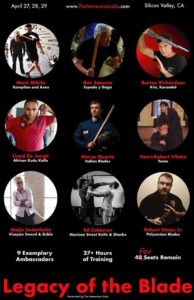 I often speak about the new renaissance of the blade in the 21st century. The romance of the sword and the horror of the knife have once again captured the minds of modern people. For three days in April, 2018, I had the pleasure of attending a martial arts seminar unlike any other.
I often speak about the new renaissance of the blade in the 21st century. The romance of the sword and the horror of the knife have once again captured the minds of modern people. For three days in April, 2018, I had the pleasure of attending a martial arts seminar unlike any other.
If you are a serious martial artist you have most likely done the seminar thing. You have put in the hours of travel. You have crowded into some small gym or hotel ballroom to get lessons from some big name martial artist. You have seen the sycophants and various star worshipers gather for the photo ops and the chance to touch greatness. You have seen egos the size of planets. You have watched dojo politicking rear its ugly head. You have seen serious students gathering to learn, and you have also observed the tacticool “ninjers” in black pajamas fantasizing that they are some sort of incarnation of the god of death and a high-speed/ low drag Blackwater style operator… when they are not working the third shift at Tony’s all Night Used Auto parts, Laundromat and Video Poker Emporium. (No offense intended to any actual uber-tactical operator ninja types who are working third shift to make ends meet. It is hard out there.)
In all of that static and noise, you might have learned some things. You might have come away a little better trained than before. You likely saw old friends and, if you were lucky, you might have made some new ones. Reading this, you might get the idea that I am not a big fan of seminars. You would be wrong. They can be great if all the pieces come together and everything is planned out and schedules adhered to. Most do not meet that simple criteria and, mind you, that is when you only have one or two presenters from the same organization. If you have 10 different instructors from diverse schools, locations, and traditions, it is another thing entirely. Logistical nightmare is an understatement. Oh yeah, and the demos in between the training… can’t forget about the demos.
Sensei Mahipal Lunia’s Vision
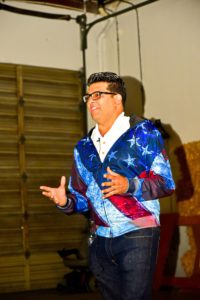
Sometime last year, Sensei Mahipal Lunia had an idea. Legend has it that it was sparked by a late night session of Escrima and whisky in a Stockton California back yard. He wanted to bring together some of the top martial arts instructors of the world, the teachers of teachers, the coaches of coaches, the masters of masters (you get the idea) for a unique, immersive seminar series. He wanted the seminars to focus on specific ideas, not styles. He wanted a seminar on bladed arts, a seminar on stick arts, a seminar on trapping arts, and so forth. He wanted to limit the size of the student body to just 40 participants to maximize the quality of the experience. And he wanted only the most committed and dedicated people present, to minimize the BS that comes when groups of people get together to participate in the pursuit of the mastery of violence.
Most people told him he was crazy and that just the politics alone would make it a herculean task — if possible at all. They told him it would never happen. There were threats. There were insults. There were plenty of naysayers with the crab mentality trying to pull Mahipal and his staff back down into the boiling pot. There were way too many hours of phone calls and meetings and planning and discussions with rival schools, but martial arts are all about overcoming challenges. Mahipal had the vision. He put together the staff and, somehow, against the odds, they made it happen.
From all over the world, teachers and students gathered in California at a private location in the heart of Silicon Valley to share, to learn, to chase after the truth that is revealed when one studies edged weapons in earnest. A little data for you to consider: The average length of the martial arts experience of the students attending the Legacy of the Blade was 18 years, but many ran as high as 50 years. Most of the students were instructors in their own right and many owned and ran their own schools, yet they still made the effort to be there and learn.
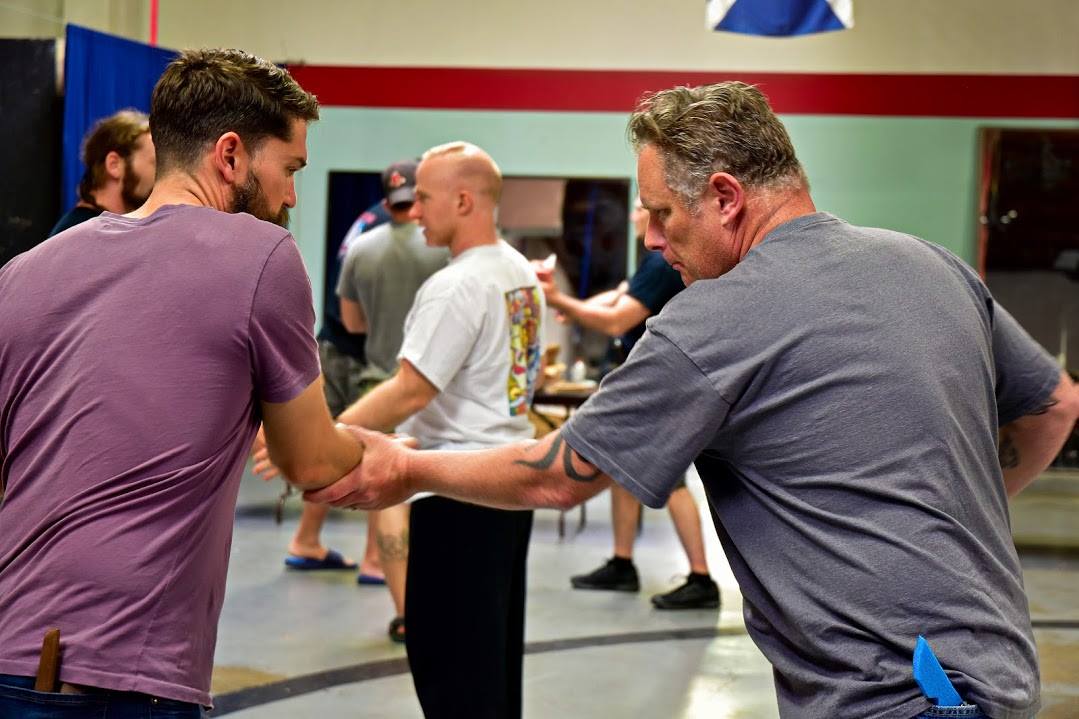
It was a veritable who’s who of the bladed martial arts world. They set aside all ego and pretension. They “emptied their cups” and embraced each other as brothers and sisters of the blade, with a unified goal of expanding their views and growing as practitioners of their individual arts. To give you an even better Idea of how serious this event was, there were no t-shirt vendors. No one was shilling their latest instructional videos. In fact, there was only one vendor present, and he was relegated to a back room. Also of note is the fact that, once the instructors were done teaching their modules, they took off their ambassador hats and got out on the floor with the rest of the students to take part in the labs as students themselves.
Legacy of the Blade: Day 1
Day one began with what can only be described as a “Meet and Greet with Knives.” Soke Robert Stines of Sanshin-Ryu Jujitsu kicked things off with a block of instruction on Polynesian blade-on-skin techniques. His scenarios and techniques dealt with the more common criminal tactics when using the knife as a tool for intimidation while committing a mugging: knife to the stomach, knife to the throat, knife to the hand, and that sort of thing.
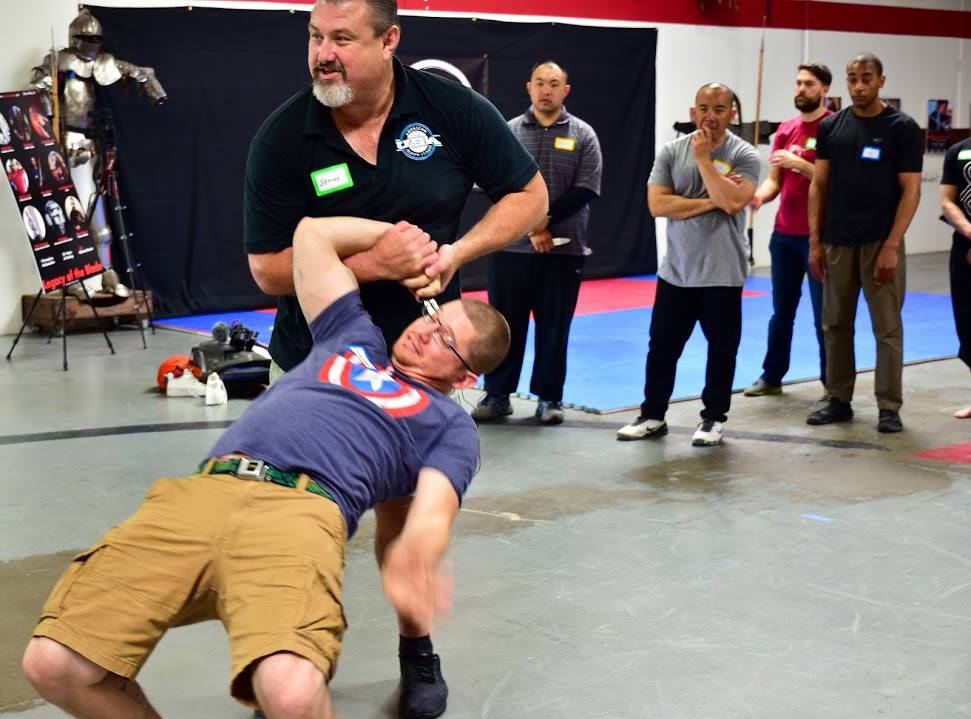
It was a great example of the maxim, “Simple does not mean easy.” Soke Stines’ instructions were clear and concise. Through each of the various scenarios, the underlying principles of the techniques were emphasized. We were also shown how they all connected to each other. For three hours, only breaking for instruction, we practiced the techniques, learning to flow through them and to react to different approaches — all while Soke Stines walked around the room correcting and adjusting, offering more in-depth information and exploration of his art’s methods.
Next, Masters Ron Saturno and Carlito Bonjoc taught the Stockton flavor of the Daga, Bolo and Espada y Daga as seen through the eyes of Cabales Serrada escrima. Guros Ron and Carlito are some of the only remaining students alive to study directly under the late Grand Master Angel Cabales.
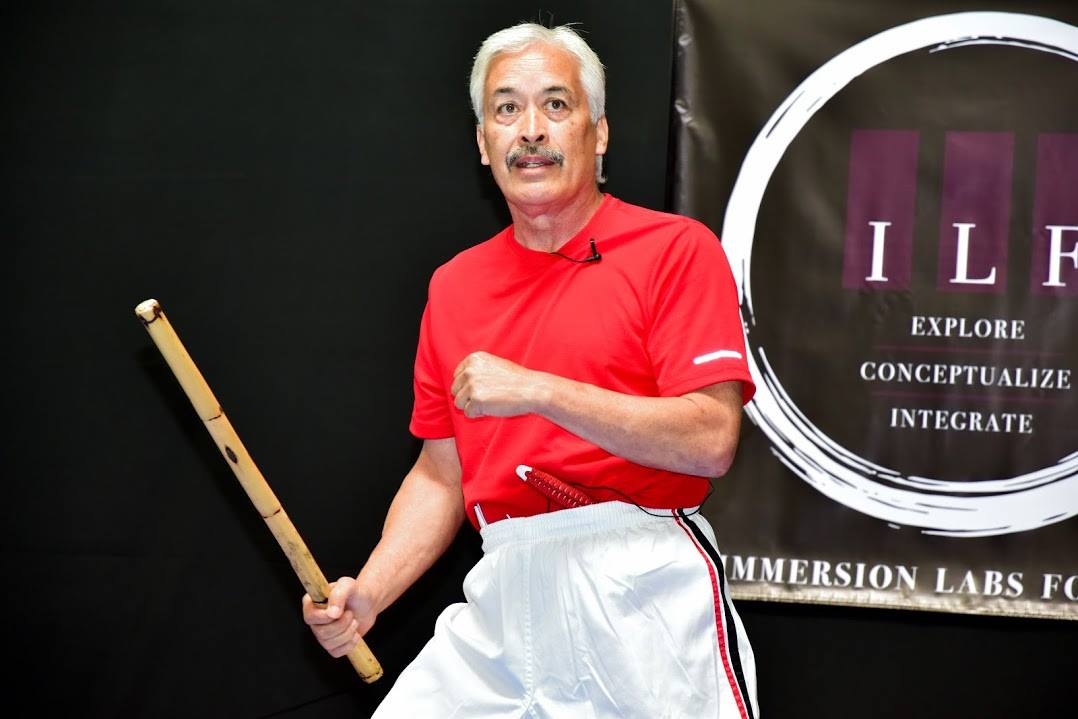
Guro Ron broke down the defensive applications of the centerline theory and how to use the system’s unique footwork to position yourself along dominant lines. Guro Carlito then taught the progressive application of an espada y daga set across all ranges.
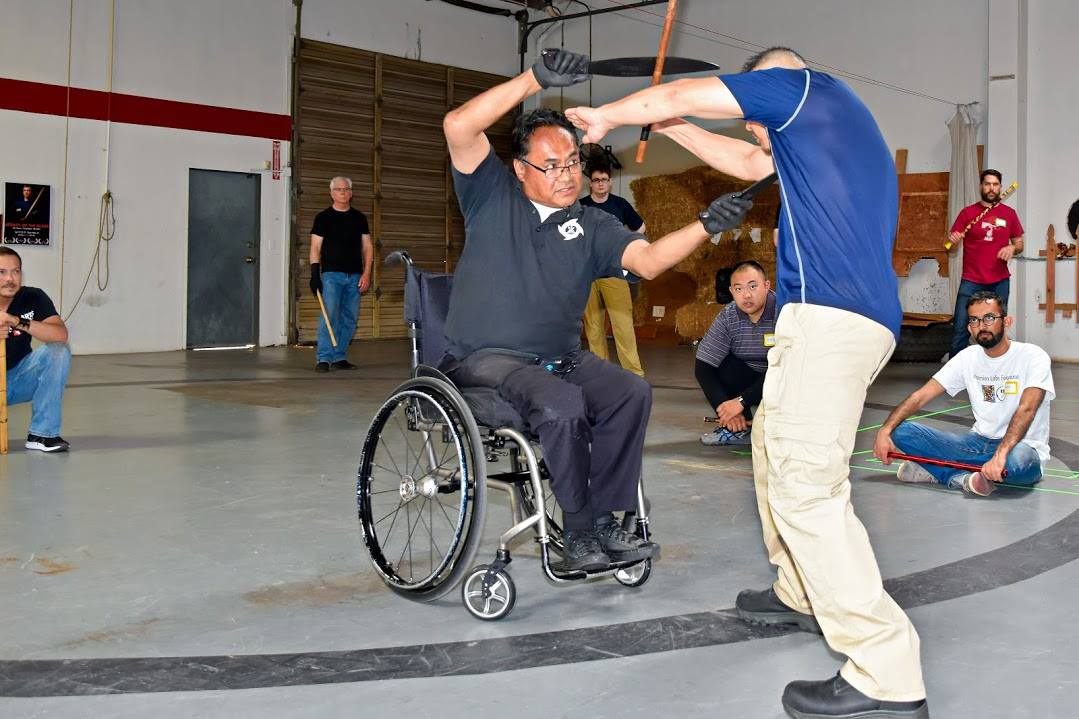
Guro Carlito is paralyzed from the waist down and operates from a wheelchair, yet he is a living terror who could leave most opponents looking like a leftover platter of turkey after a Thanksgiving Day feast. These gentlemen are some of the best escrimadors alive today. Their speed and precision is a thing of beauty to behold. Their skills were only eclipsed by their gentle humor and their ability to teach.
Once the Serrada module was over, we had completed 6 hours of hard training. Most seminars would have called it a day. Instead, we broke for dinner and then reconvened with Ed Calderon. Ed spent nearly a decade working on an anti-cartel and counter-narcotics task force in Mexico. He also coordinated and worked executive protection details for high-level government officials and visiting dignitaries. He now teaches anti-abduction, escapology, unarmed combat, region-specific executive protection work, and unconventional edged weapons work.
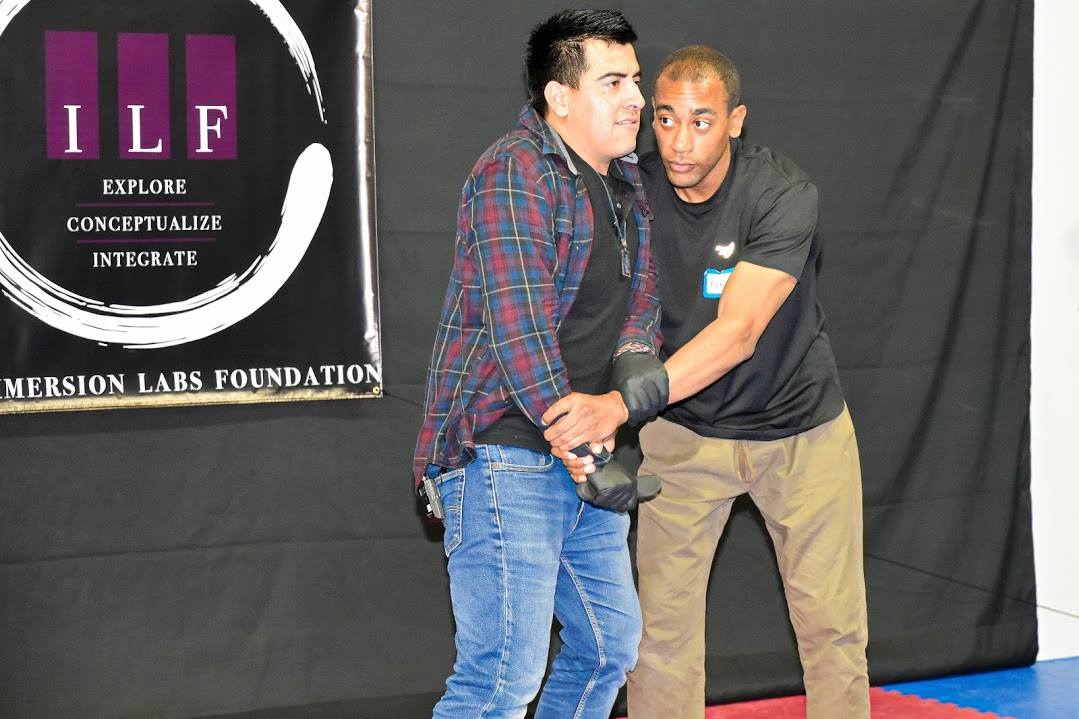
Ed is the Chief Curriculum Advisor for Libre Fighting Systems and the Regional Director of Libre Fighting Systems in Mexico. He’s the founding member of the Calidus Collective. He kind of has a clue, in other words. We delved into the criminal subculture and looked at and practiced various methods of improvised edge weapons use and concealment, as well exploring the methodology and tactics of the cartels and street criminals. Ed then gave a practical demonstration of what can only be described as “highly evolved gutter fighting.”
Legacy of the Blade: Day 2
Day two started off with a slight schedule shift due to Mr. Murphy and travel issues. The order of modules was changed to keep things moving We dove headlong into the South African Piper system with Lloyd De Jongh. If you are not familiar with Piper, that’s understandable. It is a style of fighting that comes out of the South African prison gangs. It is a combination of African stick fighting, misdirection, ambush, dirty tricks, and Dutch/Indonesian Silat.
Lloyd De Jongh was one of the first people to study Piper as well as the first guardian of the “criminal” prison system, which he then expanded to create the Trip Wire System with the intention of countering the criminal methods. The energy and approach is unlike anything else out there. Excelling at broken rhythm and striking from unconventional angles, Lloyd walked the class through the basic techniques of the system and the philosophy and evolution of the methods. He not only explained the how, but also the why.
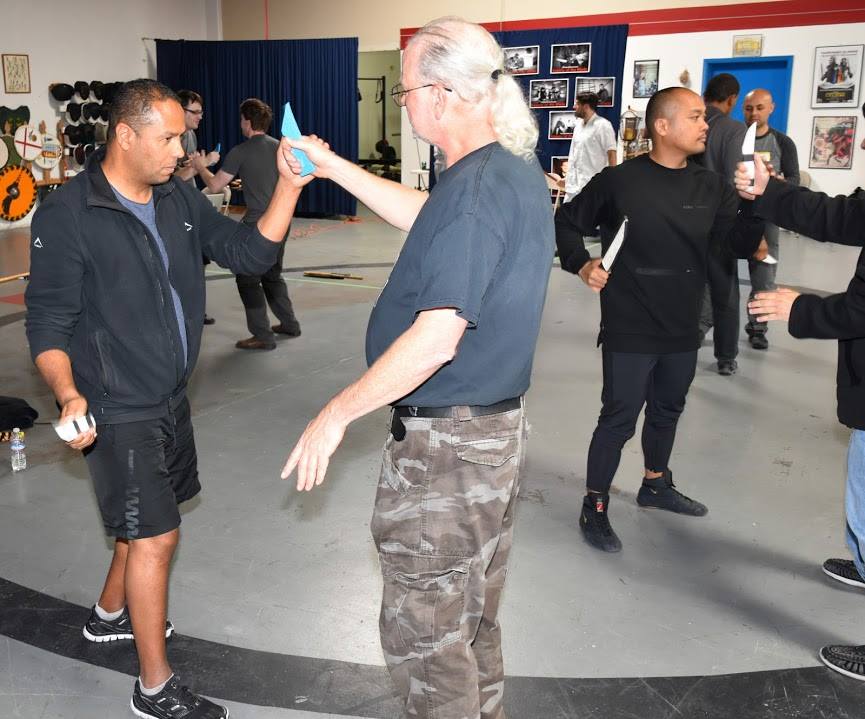
Following Lloyd was the first demo of the seminar. Master Emilio KaTa demonstrated the rare art of KaTa Tapado from the Negro mountains of the Central Visayas. Master Emilio is the last living master of this two-handed sword method. It is practiced with a two-handed kamplian style blade that measured from the xiphoid process of the user to the ground. When most think of the Filipino martial arts, grace and speed and sticks (or bolos and machetes) are what come to mind — not devastating power with a giant sword capable of chopping a man in half from stem to stern. As part of his demonstration of power generation, Master Emilio shattered several rattan batons held in the outstretched hands of volunteers. I was one of those lucky volunteers. To quote a recent movie “I have rarely felt such power.”
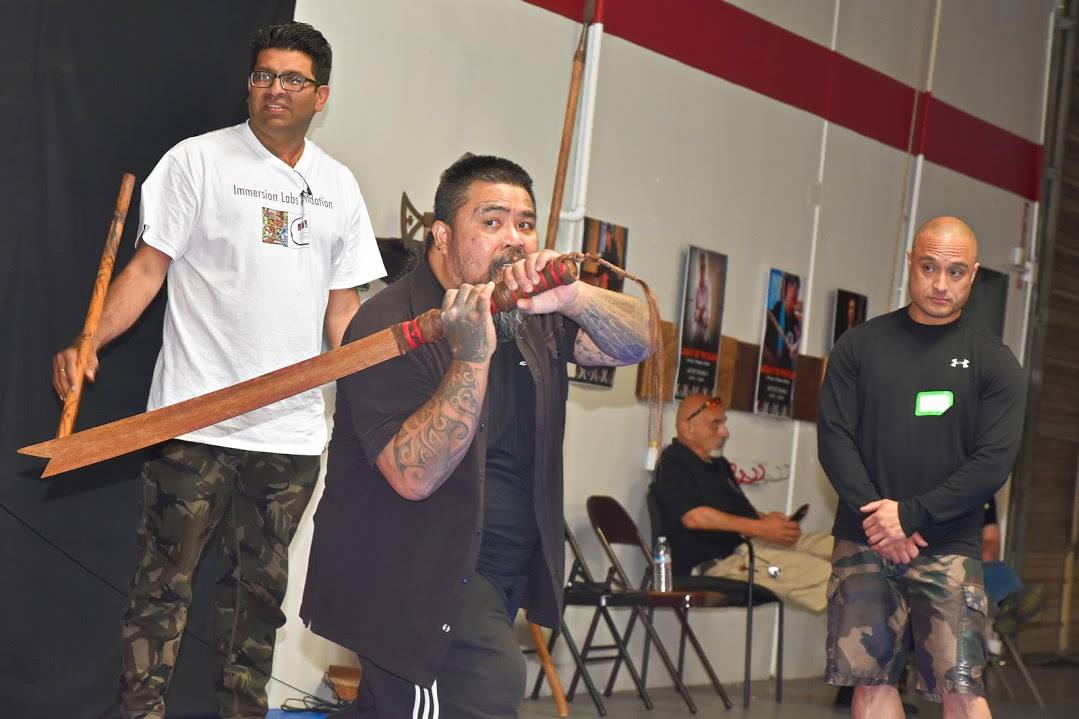
Lunch was had and Guro Mark Mikita presented his module. Starting with simple stick work to lay the foundation of the counter-offensive nature of the Philippine arts, and guiding us from theory to the application of the kamplian sword, Mark made it all look effortless. He then moved on to the use of heavier weapons such as the battle axes of the Northern Islands. This segued into melee warcraft and battlefield awareness. Mark is perhaps the most technically proficient teacher alive today. His depth of understanding of the principles of combat far exceeds that of the average master-level martial artist.
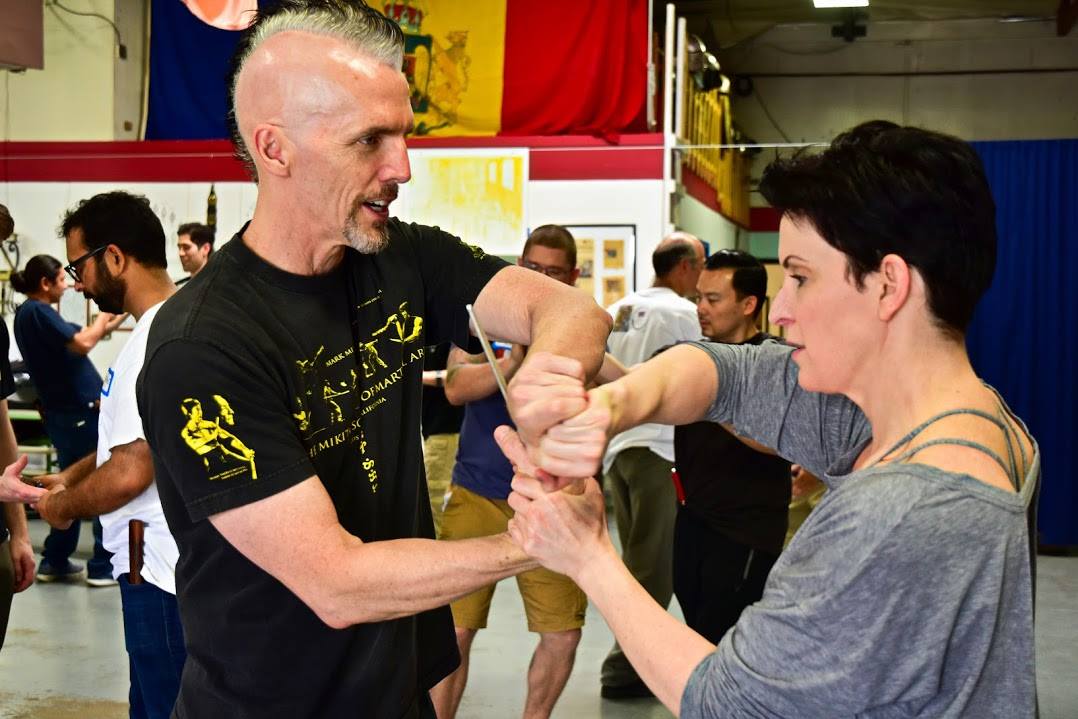
To finish day two out, Guro Burton Richardson, often acclaimed as one of America’s first Silat teachers, taught a class on the use of the karambit and the kris sword as well as giving a fascinating lesson on the history of the Filipino martial arts (and specifically the Kalis Ilustrisimo version). He was kind enough to share never-before-seen-in-public footage of Tatang Ilustrisimo.
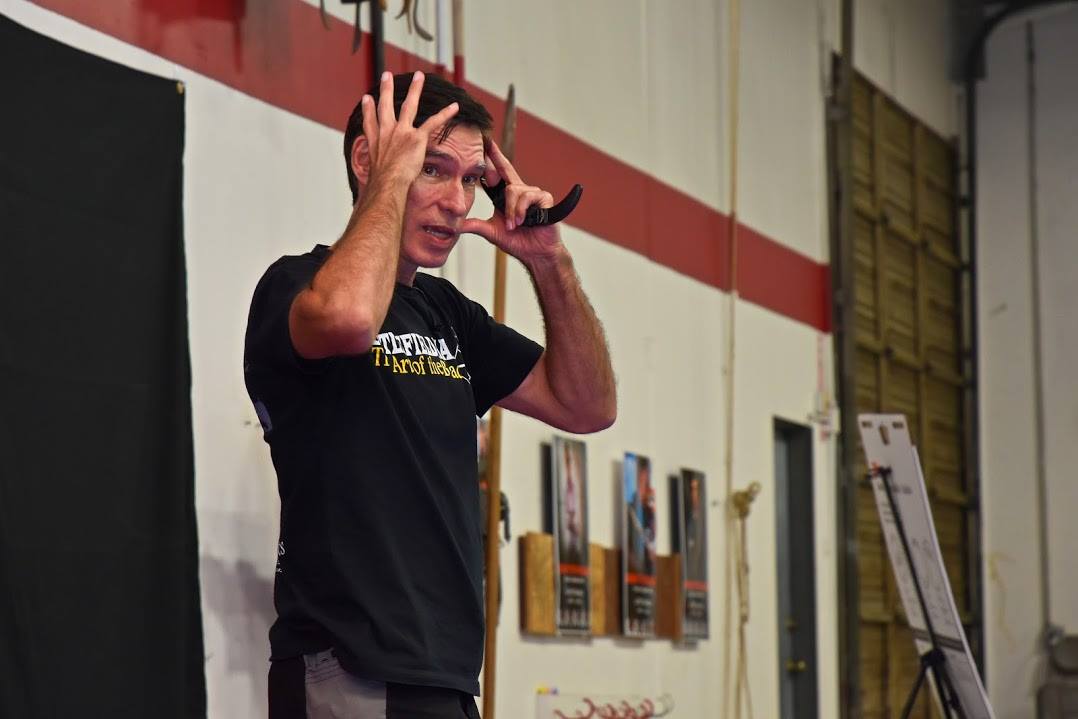
Legacy of the Blade: Day 3
Day three started with a traditional Japanese bent as we studied with Sensei Henri-Robert Vilaire. He taught the methods of Samurai tantojitsu from the Aki Jujutsu system. Quiet, humble, and highly skilled, he gave us insight into the use of the tanto as an edged impact weapon. This was for me the most physically disagreeable (tongue firmly in cheek) block of instruction as, more often than not, the tanto was used as both a stabbing instrument and a steering one. A wooden training tanto shoved into the armpit or behind the clavicle brings a new understanding to term “pain compliance.”
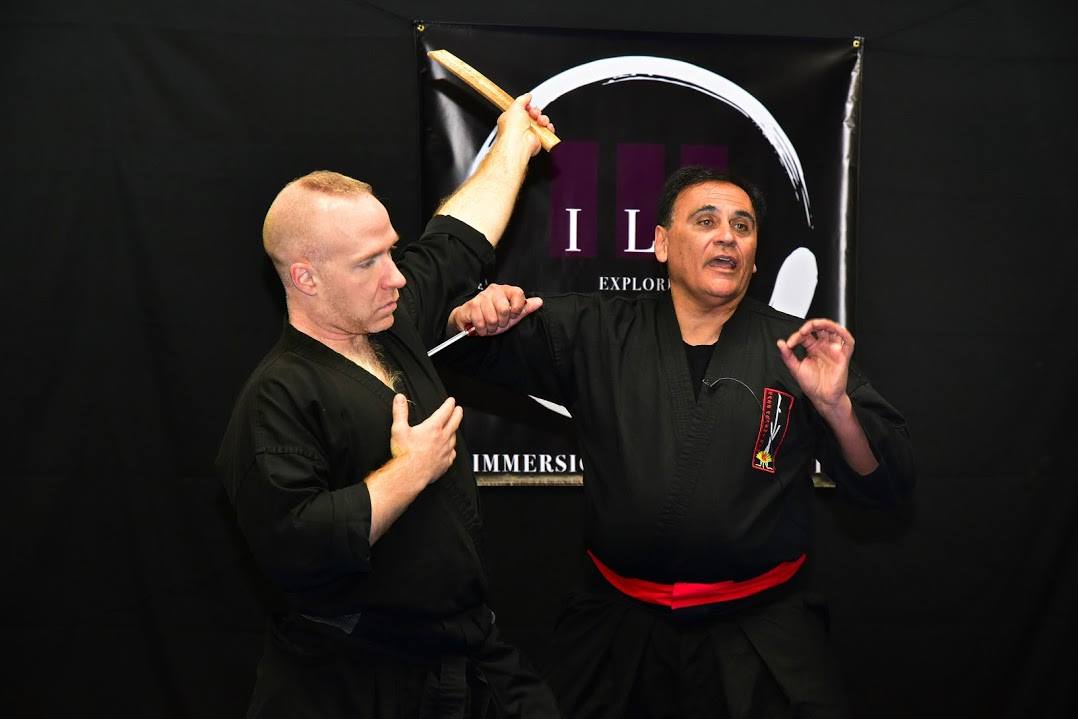
Guro Maija Soderholm then took over after lunch and taught a very comprehensive class on Maestro Sonny Umpad’s Visayan/Moro sword and sickle art, Corto Kadena. Starting at the base with the understanding that there are only three outcomes to an armed conflict (you win, they win, or you both lose), Maija showed the principles of avoidance and feinting through a progressive series of exercises. This led to a demonstration of a dance-like flow that showcased the graceful yet deadly efficiency of the late Maestro Santiago “Sonny” Umpad’s art. Once an understanding of flow was established, Guro Maija taught the use of the hand sickle in combat and showed how it could be used as a training tool for both edge awareness and blade avoidance.
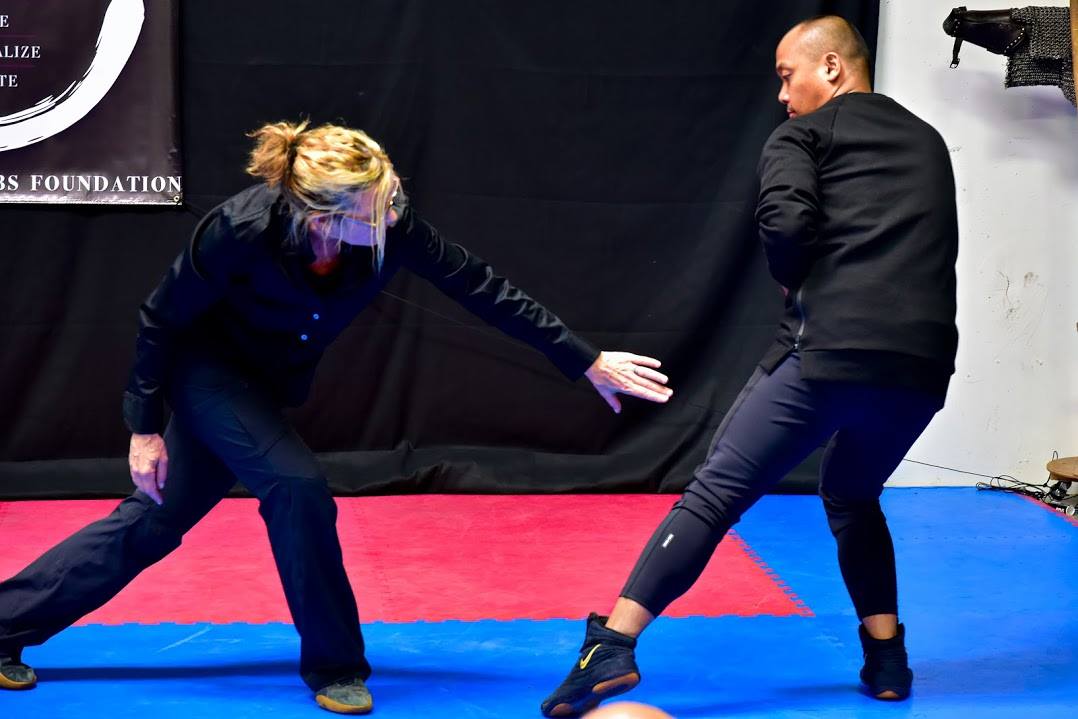
We broke for dinner once more and, after an English rapier fighting demo by Steaphen Fick, Marco Quarta of Nova Scrimia wrapped up the seminar with a class on Italian martial arts, blade culture, and methods. Rooted in the Roman Empire and the traditions of the Italian renaissance, the Italian schools take a unique and almost ritualized approach to knife-work. Marco demonstrated various living familial traditions as well as showing us how these ancient European techniques could be used in modern application.
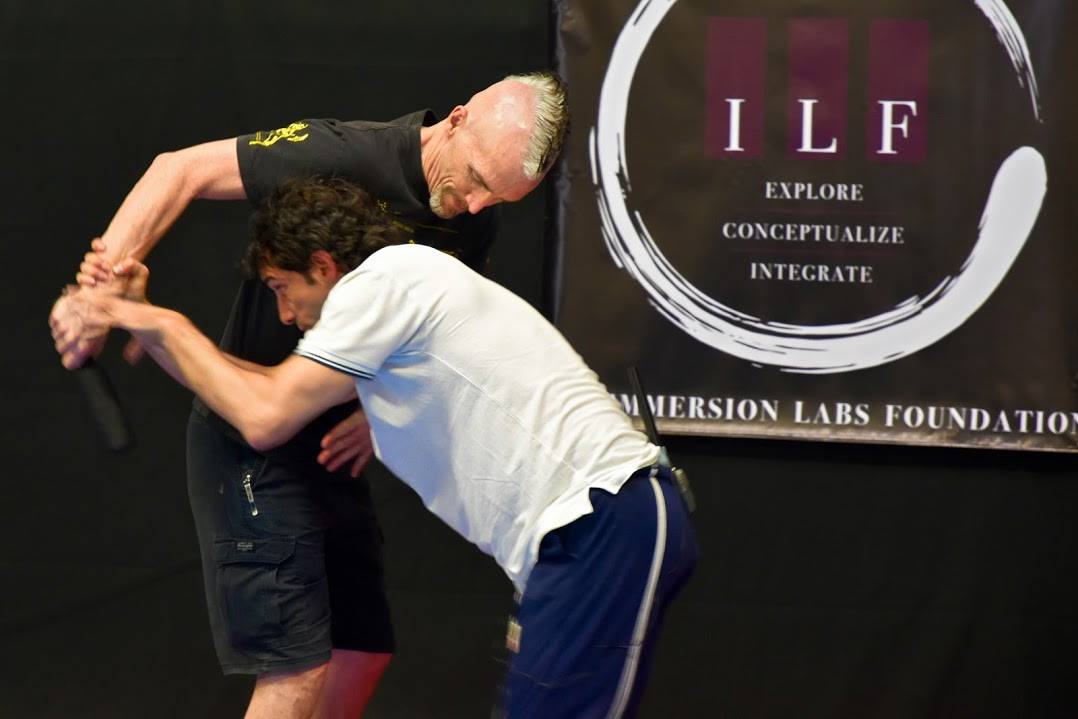
By the end of day three, all the participants were exhausted, happy, and satisfied. I must say that this was one of the good ones. There was a time in the not-too-distant past when many of these people could not have been in the same room together without blood being shed. Many would not be willing to share their arts in front of other schools’ students and teachers. Yet somehow the staff of the Immersion Labs was able to get them to come together for a common goal.
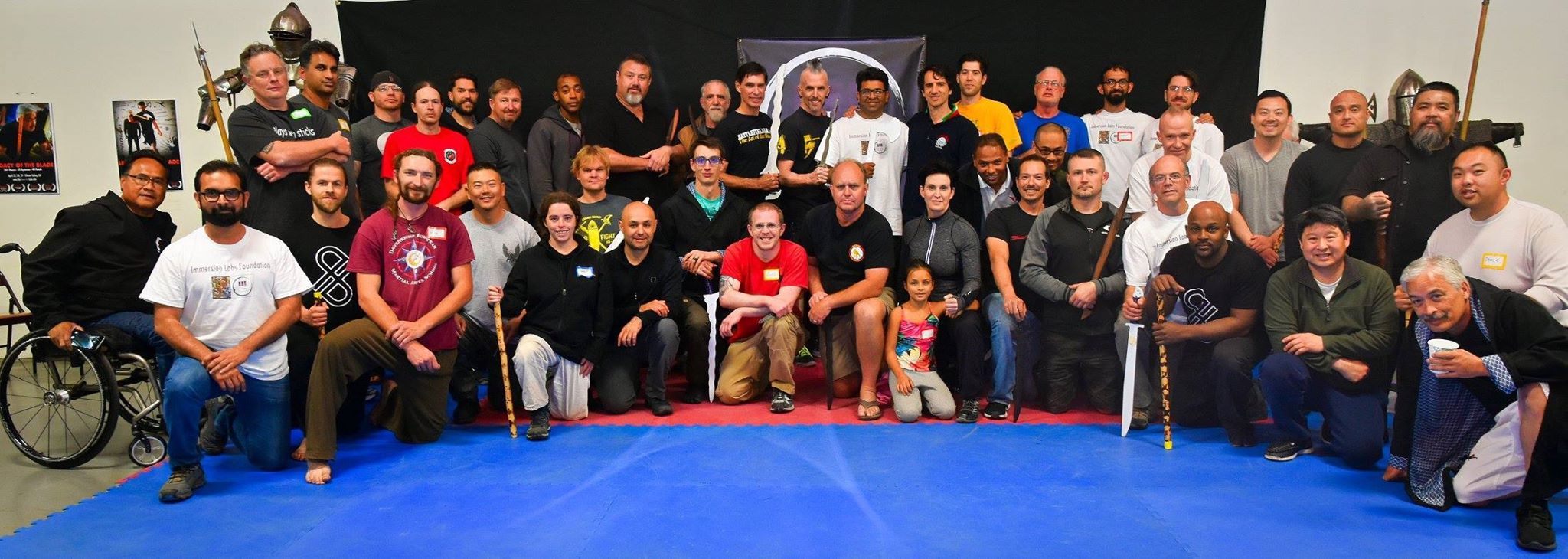
This experience was unique and a bladed lab will not be done again. I do recommend that, if you have a chance to attend any of the other upcoming Immersion labs, you do so. It will be expensive. It will be exhausting. It will be one of the best training experiences you have ever undertaken.
For more information on the Immersion Lab Foundation, check out https://www.theimmersionlabs.com or contact Sensei Mahipal at www.Mahipallunia.com.
Bryan Cannata
Cannata Tribal Martial arts
Augusta GA. 2018